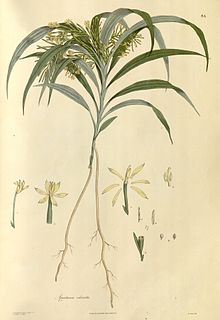
Apostasioideae is one of the five subfamilies recognised within the orchid family, Orchidaceae. Only two genera, Neuwiedia and Apostasia, and 15 species, are recognised within the Apostasioideae in contrast to the other orchid subfamilies which are highly species rich.

Apostasia, commonly known as grass orchids, is a genus of eight species of primitive orchids in the family Orchidaceae. They are terrestrial, evergreen, grass-like plants, barely recognisable as orchids and are distributed in humid areas of the Himalayan region, China, India, Sri Lanka, Southeast Asia, New Guinea, and Queensland. They have many narrow leaves and small yellow or white, non-resupinate, star-like flowers usually arranged on a branched flowering stem.

Tainia, commonly known as ribbon orchids or 带唇兰属 is a genus of about thirty species of evergreen, terrestrial orchids in the distributed from India, China, Japan, Southeast Asia to New Guinea, the Solomon Islands and Queensland.
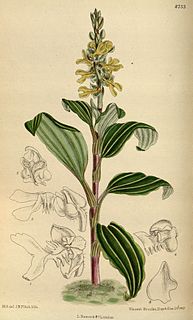
Odontochilus is a small genus from the orchid family (Orchidaceae). These terrestrial, mycoparasitic orchids occur from China, Japan, the Himalayas, Southeast Asia, New Guinea and Melanesia. The genus is related to Gonatostylis, endemic to New Caledonia.
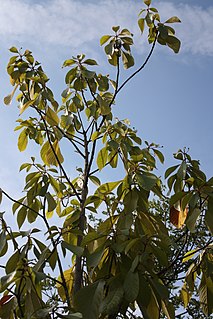
Phoebe is a genus of evergreen trees and shrubs belonging to the Laurel family, Lauraceae. There are 75 accepted species in the genus, distributed in tropical and subtropical Asia and New Guinea. 35 species occur in China, of which 27 are endemic. The first description of the genus was of the type species P. lanceolata made in 1836 by Christian Gottfried Daniel Nees von Esenbeck in Systema Laurinarum, p. 98.

Acriopsis, commonly known as chandelier orchids or 合萼兰属 is a genus of flowering plants in the family Orchidaceaes. Orchids in this genus are epiphytic herbs with spherical or cylindrical pseudobulbs, creeping, branched rhizomes, thin white roots, two or three leaves and many small flowers. The flowers are non-resupinate with the lateral sepals joined along their edges and have spreading petals and a three-lobed labellum. The column has projections that extend hood-like beyond the anther.
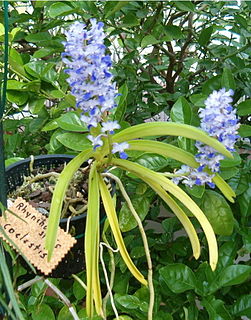
Rhynchostylis is a genus in the orchid family (Orchidaceae), closely allied to the genus Vanda and comprising four currently accepted species native to the Indian Subcontinent, China, Indochina, Malaysia, Indonesia and the Philippines. The name consists of a compound of two Greek elements : rhynchos 'beak' and stylis 'column' – in reference to the very broad, fleshy column of the flower. The flowers are borne in dense racemes and are noted for their intense, spicy fragrance. Although lacking in pseudobulbs, the plants have leathery leaves that are drought-resistant. These orchids grow naturally in warm, moist, shaded tropical areas and will thrive in cultivation if given consistent warmth, uniform moisture and bright, but indirect light. Hobbyists wanting to grow them will need a warm, humid growing environment with gentle air movement. They can be grown in pots, but are better grown in baskets, owing to the extreme fleshiness of their roots. Their unusually fragrant blooms often appear in the slightly cooler winter months.

Trichoglottis, commonly known as cherub orchids or 毛舌兰属 , is a genus of flowering plants in the family Orchidaceae. Orchids in this genus are epiphytic plants with thick roots, relatively thick, fibrous stems and many large, thick, leathery leaves arranged in two ranks. The flowers are usually small and yellowish with light brown or purple markings. The flowers have broad sepals, narrower petals and a labellum which has three lobes and is often hairy. There are about 85 species distributed from tropical and subtropical Asia to the north-western Pacific. Most species grow in rainforest.

Pholidota, commonly known as rattlesnake orchids, is a genus of flowering plants from the orchid family, Orchidaceae. Plants in this genus are clump-forming epiphytes or lithophytes with pseudobulbs, each with a single large leaf and a large number of small, whitish flowers arranged in two ranks along a thin, wiry flowering stem that emerges from the top of the pseudobulb. There are about thirty five species native to areas from tropical and subtropical Asia to the southwestern Pacific.

Neuwiedia zollingeri is a species of orchid that native to Hainan, Hong Kong, Yunnan, Borneo, Sumatra, Java, Bali, Malaysia, Singapore, Thailand, Vietnam.
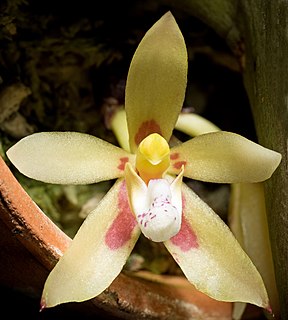
Brachypeza, commonly known as sage orchids, is a genus of flowering plants from the orchid family, Orchidaceae. Orchids in this genus have short stems with fleshy leaves and arching flowering stems with short-lived flowers. The sepals and petals are similar in size and shape and the labellum is pouch-like and suspended at the base of the flower. Sage orchids occur in tropical areas from Indochina to New Guinea.

Chrysoglossum is a genus of flowering plants from the orchid family, Orchidaceae. Its 4 species are native to China, the Indian Subcontinent, southeast Asia, New Guinea and some islands of the western Pacific.
- Chrysoglossum assamicumHook.f.. - Guangxi, Tibet, Assam, Thailand, Vietnam
- Chrysoglossum ensigerumW.Burgh & de Vogel - Sumatra
- Chrysoglossum ornatumBlume - India, Nepal, Assam, Bhutan, Sri Lanka, Cambodia, Thailand, Vietnam, Malaysia, Java, Borneo, Sulawesi, Sumatra, Philippines, New Guinea, Fiji, New Caledonia, Samoa, Vanuatu, China
- Chrysoglossum reticulatumCarr - Sabah, Sarawak

Grosourdya is a genus of flowering plants from the orchid family, Orchidaceae. As of May 2022, it contains 26 known species, native to Southeast Asia.
- Grosourdya appendiculata(Blume) Rchb.f. - widespread from Hainan to the Andaman Islands to the Philippines and Maluku
- Grosourdya bicornutaJ.J.Wood & A.L.Lamb - Sabah
- Grosourdya bigibba (Schltr.) Kocyan & Schuit.
- Grosourdya calliferaSeidenf. - Thailand
- Grosourdya ciliata (Ridl.) Kocyan & Schuit.
- Grosourdya decipiens (J.J.Sm.) Kocyan & Schuit.
- Grosourdya emarginata (Blume) Rchb.f.
- Grosourdya fasciculata (Carr) Kocyan & Schuit.
- Grosourdya incurvicalcar(J.J.Sm.) Garay - Java, Peninsular Malaysia, Sulawesi
- Grosourdya leytensis (Ames) Kocyan & Schuit.
- Grosourdya lobata Kocyan & Schuit.
- Grosourdya milneri P.O'Byrne, Gokusing & J.J.Wood
- Grosourdya mindanaensis (Ames) Kocyan & Schuit.
- Grosourdya minutiflora(Ridl.) Garay - Pahang
- Grosourdya minutissima P.T.Ong & P.O'Byrne
- Grosourdya multistrata P.O'Byrne, J.J.Verm. & S.M.L.Lee
- Grosourdya muscosa(Rolfe) Garay - Peninsular Malaysia, Thailand, Andaman Islands
- Grosourdya myosurus (Ridl.) Kocyan & Schuit.
- Grosourdya nitida (Seidenf.) Kocyan & Schuit.
- Grosourdya pulvinifera(Schltr.) Garay - Sabah, Sulawesi
- Grosourdya quinquelobata(Schltr.) Garay - Sulawesi
- Grosourdya reflexicalcarP.O'Byrne & J.J.Verm.
- Grosourdya tripercus(Ames) Garay - Leyte
- Grosourdya urunensisJ.J.Wood, C.L.Chan & A.L.Lamb - Sabah
- Grosourdya vietnamica (Aver.) Kumar & S.W.Gale
- Grosourdya zollingeri(Rchb.f.) Rchb.f. - Java, Maluku

Vrydagzynea, commonly called tonsil orchids, is a genus of orchids in the tribe Cranichideae. About forty five species of Vrydagzynea have been formally described. They are native to India, Taiwan, Southeast Asia, Malesia, Melanesia and Polynesia. A single species in Australia is possibly extinct. They have thinly textured, stalked leaves and small, dull-coloured resupinate flowers with the dorsal sepal and petals overlapping to form a hood over the column.

Thelasis, commonly known as fly orchids, is a genus of flowering plants from the orchid family, Orchidaceae. Plants in this genus are usually epiphytes, sometimes lithophytes or rarely terrestrials. Some species have pseudobulbs with up to three leaves, whilst others have several leaves in two ranks. A large number of small, white or greenish yellow flowers are borne on a thin, arching flowering stem. There are about thirty species, distributed from tropical and subtropical Asia to the southwest Pacific.

Micropera, commonly known as dismal orchids or 小囊兰属 is a genus of about twenty species of flowering plants from the orchid family, Orchidaceae. Plants in this genus are large epiphytes with thick roots, long, fibrous stems, linear leaves and whitish or yellow, non-resupinate flowers. The sepals and petals are similar to each other and the labellum is shoe-shaped or sac-like and has three lobes. It is found from Tibet to tropical Asia and the western Pacific Ocean.
Microsaccus is a genus of flowering plants from the orchid family, Orchidaceae. It is native to Southeast Asia.
- Microsaccus affinisJ.J.Sm. - Java
- Microsaccus albovirescensJ.J.Sm. - Sumatra
- Microsaccus ampullaceusJ.J.Sm. - Sumatra, Borneo, Malaysia
- Microsaccus borneensisJ.J.Sm. - Borneo
- Microsaccus canaliculatusJ.J.Sm. - Sumatra
- Microsaccus dempoensisJ.J.Sm. - Sumatra
- Microsaccus griffithii(C.S.P.Parish & Rchb.f.) Seidenf. - Cambodia, Myanmar, Thailand, Vietnam, Borneo, Malaysia, Java, Sumatra, Philippines
- Microsaccus javensisBlume - Malaysia, Java
- Microsaccus ramosusJ.J.Sm. - Java
- Microsaccus sumatranusJ.J.Sm. - Malaysia, Sumatra
- Microsaccus truncatusCarr - Malaysia
- Microsaccus wenzeliiAmes - Philippines

Myrmechis is a genus of flowering plants from the orchid family, Orchidaceae. It is native to eastern and southeastern Asia from the Kuril Islands south to New Guinea, west to the Himalayas.
- Myrmechis aurea(J.J.Sm.) Schuit. - Maluku
- Myrmechis bakhimensisD.Maity, N.Pradhan & Maiti - Sikkim
- Myrmechis bilobulifera(J.J.Sm.) Schuit. - Sulawesi
- Myrmechis chalmersii(Schltr.) Schuit. - New Guinea
- Myrmechis chinensisRolfe - Sichuan, Hubei, Fujian
- Myrmechis drymoglossifoliaHayata - Taiwan
- Myrmechis glabraBlume - Java
- Myrmechis gracilis(Blume) Blume - Java, Sumatra, Philippines
- Myrmechis japonica(Rchb.f.) Rolfe - Japan, Korea, Kuril Islands, Fujian, Sichuan, Tibet, Yunnan
- Myrmechis kinabaluensisCarr - Sabah
- Myrmechis perpusillaAmes - Luzon
- Myrmechis philippinensiisAmes - Philippines
- Myrmechis pumila(Hook.f.) Tang & F.T.Wang - Yunnan, Bhutan, Assam, Myanmar, Nepal, Thailand, Vietnam
- Myrmechis quadrilobata(Schltr.) Schuit. - Sulawesi
- Myrmechis seranicaJ.J.Sm. - Seram
- Myrmechis tsukusianaMasam. - Yakushima
- Myrmechis urceolataTang & K.Y.Lang - Yunnan, Guangdong, Hainan

Pteroceras is a genus of flowering plants from the orchid family, Orchidaceae. It is native to China, the Indian Subcontinent, and Southeast Asia.
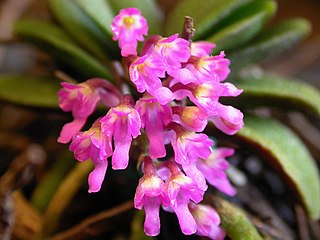
Schoenorchis, commonly known as flea orchids, or 匙唇兰属 , is a genus of flowering plants from the orchid family, Orchidaceae. Plants in this genus are small epiphytes with thin roots, thin leafy stems with leaves in two ranks and tiny fragrant, almost tube-shaped flowers with a prominently spurred labellum. There are about twenty five species found from tropical and subtropical Asia to the Western Pacific.



















